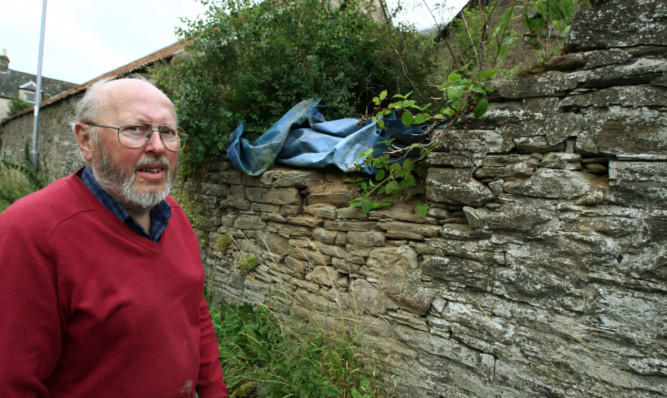A Liff man is facing a long and costly legal battle over the repair of his centuries- old drystone wall after it was damaged by roadworks outside his house.
Ian Glenn sued Angus Council and Tayside Contracts for more than £17,000 for the cost of rebuilding the wall on the west side of his garden on Church Road.
He won his case, with a sheriff in Forfar ruling that the council should have carried out a proper survey of the structure before allowing the public works organisation to upgrade the rural thoroughfare.
But the council is appealing the decision and the case is now going to the Court of Session, where Mr Glenn said the cost of legal representation will be high.
Mr Glenn’s eight-foot wall was built between 250 and 300 years ago. It is about 22 feet long and 20 inches deep but had shallow foundations.
On January 27 2009 Tayside Contracts had a JCB digger working on soil removal near to the wall. This involved raising and lowering the bucket weighing many tons and banging it against the road for about two hours, causing loud vibrations.
Two sections of the wall collapsed and other parts had to be taken down to make them safe before the wall could be repaired.
The civil action at Forfar Sheriff Court heard that before the works began the road and adjacent properties were inspected by Sandy Garden, for the council, and Brian Johnston, for Tayside Contracts.
Mr Garden did not think the wall was potentially vulnerable but Sheriff Derek O’Carroll said that he was mistaken.
“He did not instruct a survey to be carried out by a structural engineer to assess the state of the wall and its potential vulnerability to the roadworks,“ the sheriff stated. “He did not put in place any precautions to safeguard the wall.”
However, Mr Johnston thought the wall might be vulnerable and told the council.
The sheriff found that the reason for the wall coming down was the activities of the JCB. The repeated banging of the heavy digger bucket caused vibrations to be transmitted along the road, up through the foundations and into the wall and eventually led to the collapse.
The sheriff noted that the council served a dangerous buildings notice on Mr Glenn, requiring him to repair and rebuild the wall. He had the work done at a cost of £17,395.
Mr Glenn sued the council and Tayside Contracts for the cost of the work. Sheriff O’Carroll ruled that all the blame lay with the council and ordered it to pay him.
Angus Council has lodged an appeal, contending that she sheriff erred in finding that it had not taken reasonable care to see the wall was adequately protected.
Documents lodged at the Court of Session say the sheriff noted the council ought to have put precautionary measures in place but he did not specify the measures.
“Evidence was heard that any possible precautionary measures would have been impractical or unreasonable.
“Accordingly the sheriff left a relevant consideration out of account and did not consider whether there could be a breach of duty in the absence of proof of reasonable and practical precautions.”
